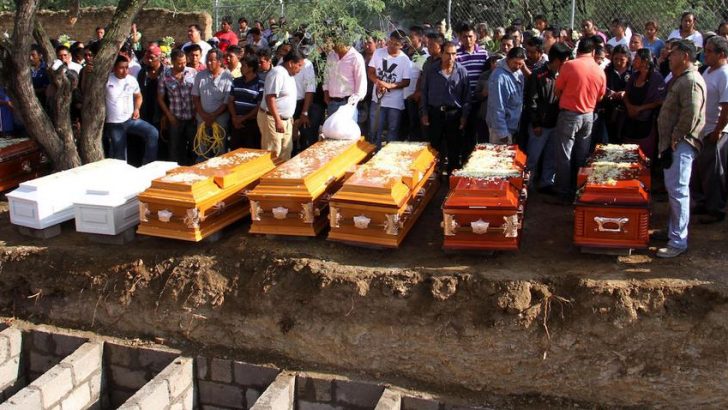Ahead of the Pope’s official visit to Mexico, Paul Keenan examines the country’s ongoing struggle against drug violence.
Whether Archbishop Jose Guadalupe Martin Rabago’s appeal for a period of peace during Pope Benedict’s March visit to Mexico (see Page 19) will be acknowledged by the violent criminal fraternity there remains to be seen.
The cautiously optimistic might point out that with a rate of Catholic observance among Mexicans still holding at 76 per cent, those normally bent on violence in the ongoing war between drugs cartels and the government (a drive launched by President Felipe Calderón in 2006) might be inspired by the papal visit to rekindle what faith they have for the duration of the March 23-26 visit at least.
The willingness of many criminals to pray and make offerings to Santa Muerte — a perversion of Marian devotion — hints at a lingering faith that may be tapped into by a Pope who will no doubt speak on the issue of violence while on Mexican soil.
How could he not? In the six years since the presidential declaration of war on Mexico’s narco-industry, nearly 50,000 people have died, many in unspeakable circumstances as the drugs cartels give vent to the most depraved actions to terrorise their competition and wider Mexican society. Among them, 12 priests killed in the course of their ministry.
While it might easily be argued that any hope the Pontiff has of reaching brutal killers lies in the Mexican dust with these 12 dead, it should be pointed out that the same 12 victims, more than any others, serve to damage the veneer of respectability so eagerly sought by cartel members in their offerings to Santa Muerte or through public expression.
(Pictured: Family members mourn brother Sotero and Ismael Reyes Ricario, shot dead in Ciudad Juarez, Mexico. Photo: CNS)
Mexican gangsters often cover their crimes by claiming that the dead — men, women and children — were linked to a rival gang, involved in extortion and kidnapping (no demonising of drugs peddling, however).
A graphic example of this was presented to commuters in Boca del Rio last September when gunmen stopped traffic on a busy highway before dumping 35 bodies on the road with signs alleging the dead were members of the infamous Zetas gang (made up of former soldiers).
A number of the dead showed signs of torture — a perverse pursuit of the greater good by the drugs gang acting as self-appointed guardians of their community.
More sickening, one gang, an offshoot of the Zetas, known as La Familia Michoacana, takes its inspiration from its Bible-quoting founder and a Jehovah’s Witness convert from Catholicism, Nazario Moreno González, who asserted the divine right of his followers to kill enemies.
But priests are not ‘enemies’ or gang members.
Violence
At the time of the Boca del Rio killings, President Calderón was in New York to address the UN General Assembly. There, he did not exaggerate when he told the UN that ”organised crime is killing more people and more youngsters than all the dictatorships put together”.
The figures for victims indeed remain stark. In 2011 alone, between January and September, 12,903 people died as a result of drug-related violence, an increase of 447 over the same period in 2010.
Mexico’s attorney general’s office and the National System of Public Security have been keen to point out that the actual growth in numbers is slowing, but to put this in context, the 3,000 dead in 2010 in the city of Ciudad Juarez — bordering the US city of El Paso — represents a tenfold increase in violent deaths since 2006.
If there are silver linings to be found, they can be perceived in recent successes by police whose intelligence gathering has vastly improved (if levels of corruption have not) over the last six years.
Proof of the pudding lies in the parade of faces of leading cartel members in front of Mexican television cameras in recent months.
One of those unable to participate is Nazario Moreno González who died in a police shootout in 2010.
Also on the plus side, it must be acknowledged that, for all its bloody reputation, Mexico’s drugs violence is largely confined to 162 provinces from a total of 2,456, with the remainder showing low levels of violence.
Unfortunately, both for Mexico and Archbishop Rabago, even as this report was being compiled, 12 men were gunned down in the state capital of Nuevo León, Monterrey.
A lone woman found dead elsewhere was also linked to the same shooting. Again the gang name Zetas surfaced as police cordoned off the area, another crime scene in a city that has, for the last 18 months, been the scene of inter-gang fighting for territorial control.
Meanwhile, five police officers were gunned down in the city of Ixtapaluca, leading to the arrests of four people believed to be linked to La Familia Michoacana.
The war continues, and with Mexico now engaged in the world’s largest spraying project in a drive to finally kill poppy and marijuana crops, and the gangs adapting to this by diversifying into methamphetamine production (becoming America’s largest foreign supplier in the process), the conflict is far from over.
A ceasefire in March would be a blessing.


 Paul Keenan
Paul Keenan
